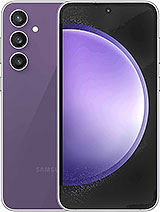Samsung Galaxy S23 FE alternatives
Tap above to see alternatives.
Vivo T4x alternatives
Tap above to see alternatives.
Samsung Galaxy S23 FE

Samsung Galaxy S23 FE
-
Exynos 2200
4 nm
-
4500 mAh
25W
-
6.4"
1080 x 2340 pixels
-
50 MP
8K@24fps
- Specs
1x2.8 GHz Cortex-X2
3x2.50 GHz Cortex-A710
4x1.8 GHz Cortex-A510
4x2.5 GHz Cortex-A78
4x2.0 GHz Cortex-A55
8GB 256GB
8GB 128GB (UFS 3.1)
8GB 256GB (UFS 3.1)
1x3.00 GHz Cortex-X2
3x2.50 GHz Cortex-A710
4x1.80 GHz Cortex-A510
8GB 256GB
f/1.8, 24mm (wide), dual pixel PDAF, OIS
8 MP
f/2.4, 75mm (telephoto), PDAF, OIS, 3x optical zoom
12 MP
f/2.2, 123˚ (ultrawide)
f/1.8, (wide), PDAF
2 MP
f/2.4, (depth)
4K@30/60fps
1080p@30/60/120/240fps
720p@960fps
1080p@30fps
f/2.4, 26mm (wide)
f/2.1, (wide)
1080p@30/60fps
SIM1: Nano, SIM2: eSIM
SIM1: Nano, SIM2: Nano
14 5G bands
n1, n2, n3, n5, n7, n8, n20, n28, n38, n40, n41, n66, n77, n78
8 5G bands
n1, n3, n5, n8, n28, n40, n77, n78
In this performance comparison, the Samsung Galaxy S23 FE with its Exynos 2200 (4nm) performs better than the Vivo T4x with the Mediatek Dimensity 7300 (4nm), thanks to superior chipset efficiency.
Samsung Galaxy S23 FE offers 4 years of OS updates, whereas Vivo T4x provides 2 years. For security updates, Samsung Galaxy S23 FE offers 5 years of support compared to Vivo T4x's 3 years.
Samsung Galaxy S23 FE features a superior AMOLED display, while Vivo T4x comes with an LCD panel. Both smartphones offer the same 120 Hz refresh rate. Samsung Galaxy S23 FE also boasts a brighter screen with 1450 nits of peak brightness, enhancing outdoor visibility. Both phones have the same screen resolution.
Vivo T4x features a larger 6500 mAh battery, potentially delivering better battery life. Vivo T4x also supports faster wired charging at 44W, compared to 25W on Samsung Galaxy S23 FE. Samsung Galaxy S23 FE supports wireless charging at 15W, while Vivo T4x does not support wireless charging.
Samsung Galaxy S23 FE offers better protection against water and dust with an IP68 rating.
¹ Scores can vary even with the same chipset due to RAM, thermals, and software optimization.











